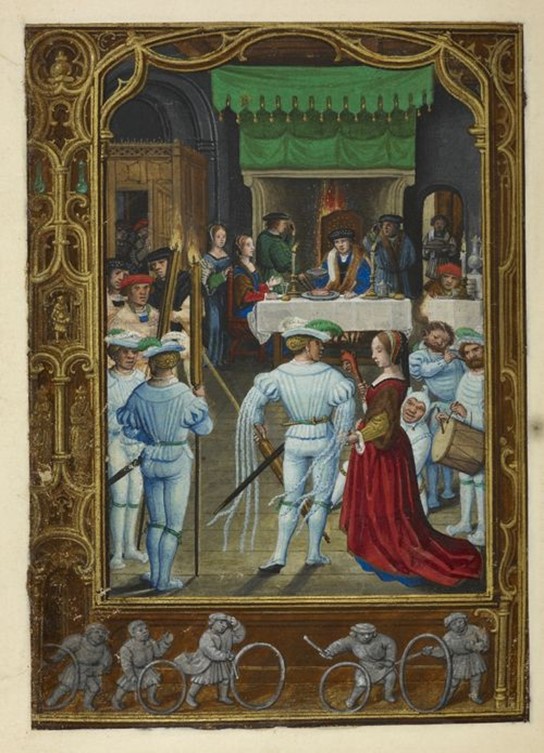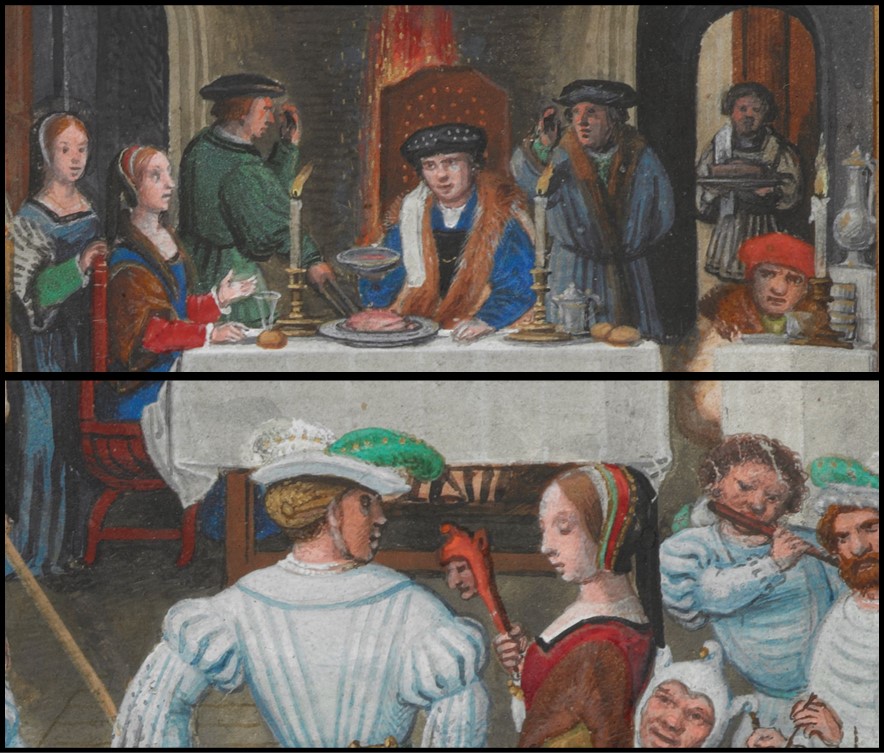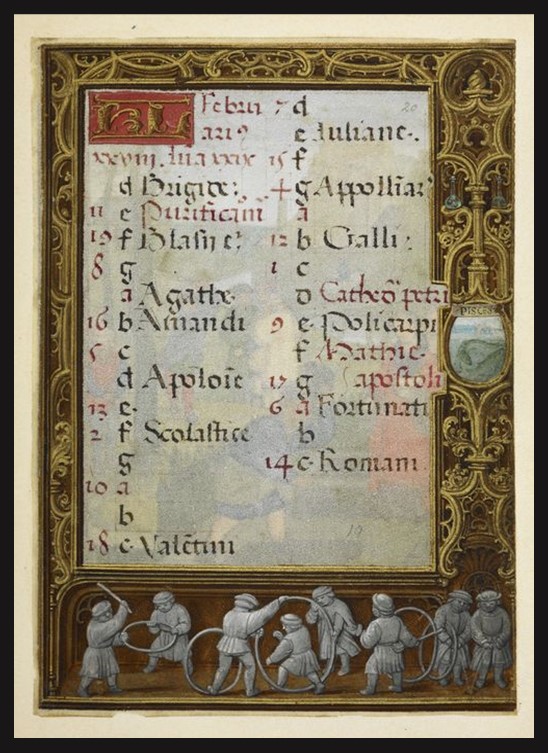
Book of Hours, known as the Golf Book, February (f. 19v),c. 1540, 30 Parchment leaves on paper mounts, bound into a codex, 110 x 80 mm (text space: 85 x 60 mm), British Library, London, UK
https://blogs.bl.uk/digitisedmanuscripts/calendars/page/11/
Simon Bening’s February scene is a feast for the eyes! Under an impressive green canopy, and in front of a blazing fire the lord and the lady of the Manor House are ready for an evening of festivities and fine dining. Seated on a high-backed chair, a symbol of her social rank, and attended by her handmaiden, the lady of the manor is portrayed spirited, and enthusiastic, chatting with her husband who seems interested, like-minded, and responding. He is lavishly clothed in a tunic with a sable collar holding a bowl of liquid. Like most of the men in the room except the servants, musicians and the dancer, the lord wears a small, soft cap with a slightly raised crown and very narrow rim. The shirt collar, of German origin, is quite high and trimmed by a narrow, gathered edge. Bening presents them in a richly-appointed room, behind an opulent dining table laden with two candlesticks each with a lit candle, a platter of meat, loaves of bread, a metal container possibly for drinks, and a glass goblet which reveals the high social standing of the figures. The large proportions of the room and compositional depth are enhanced by the presence of two doors, on either side of the fireplace. A group of crammed, curiously-looking men is depicted through the left door, and a serious servant carrying a bowl of food emerges through the right door. We are witnesses of a true Renaissance feast in the making! https://www.moleiro.com/en/books-of-hours/the-golf-book-book-of-hours/miniatura/157 and https://blogs.bl.uk/digitisedmanuscripts/calendars/page/11/

Book of Hours, known as the Golf Book, February (f. 19v),c. 1540, 30 Parchment leaves on paper mounts, bound into a codex, 110 x 80 mm (text space: 85 x 60 mm), British Library, London, UK
http://www.bl.uk/manuscripts/Viewer.aspx?ref=add_ms_24098_fs001r
For Simon Bening, presenting a scene of feasting is not enough! I sense anticipation rising high… I imagine the hosts, the servants, and the guests eager for the entertainment to begin! A troop of musicians… accompanied by a rather mischievous-looking jester, are ready! To the left of the composition, two servants holding torches, just like Renaissance spotlights, illuminate the scene. On the opposite side, a group of musicians playing a melody on a flute to the sound of a drum set the tone for merriment! Beside them is a jester or fool in the typical horned cap with bells and mock scepter. He looks utterly mischievous… Is he about to make some impudent, risqué comment? Is the young, a fashionably dressed couple in the center, the target of his bold wit? https://www.moleiro.com/en/books-of-hours/the-golf-book-book-of-hours/miniatura/157 and https://blogs.bl.uk/digitisedmanuscripts/calendars/page/11/
Simon Bening takes time and effort to present us with a powerful couple of impeccable tastes… stylish, and trendy! They are about to start dancing, and he is the protagonist of the scene… wearing a doublet with gusseted sleeves and full-length hose with a ribbon tied around each leg. He differs from the others, present in the composition, by his loose, decorative, slit sleeves hanging from the forearm… the golden dagger tied to his waist… his narrow, closed footwear, of the duck’s beak type that appeared around 1530. What an amazing presentation! We can only speculate which winter feast is celebrated on Bening’s February page. Perhaps a feast related to Carnival, as suggested by the image of another small jester painted in cameo fashion in a niche on the left of the border around the painting. Perhaps not… https://www.moleiro.com/en/books-of-hours/the-golf-book-book-of-hours/miniatura/157
For a PowerPoint on the Golf Book, please… Check HERE!
For a Student Activity on Simon Bening’s February page, please… Check HERE!

Book of Hours, known as the Golf Book, February (f. 20r),c. 1540, 30 Parchment leaves on paper mounts, bound into a codex, 110 x 80 mm (text space: 85 x 60 mm), British Library, London, UK
https://blogs.bl.uk/digitisedmanuscripts/calendars/page/11/